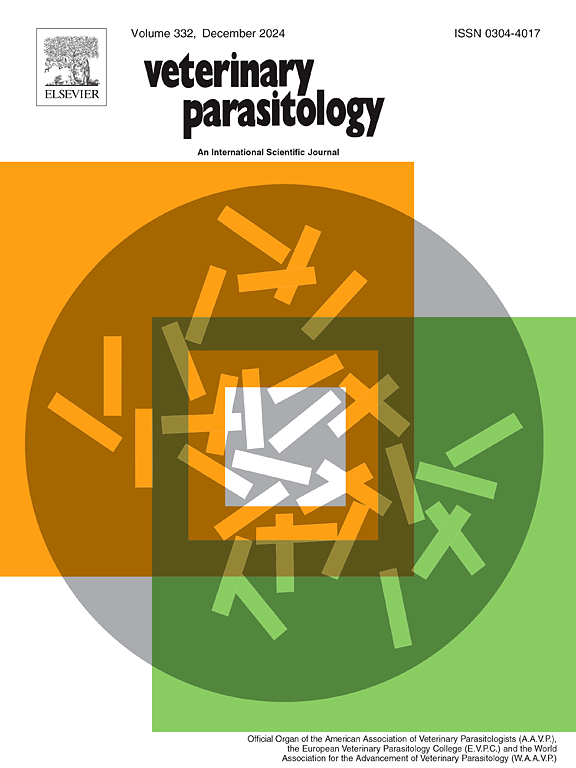通过无人机在牧场上施用紫云英真菌对控制蜱 Rhipicephalus (Boophilus) microplus(Acari: Ixodidae)的功效。
IF 2
2区 农林科学
Q2 PARASITOLOGY
引用次数: 0
摘要
在巴西东南部地区,Rhipicephalus (B.) microplus 这类蜱虫一年四季都在牛身上出没。这是由于气候条件有利于这些蜱虫的生物学特性,以及对使用中的杀螨剂产生了抗药性。这项研究的目的是评估粉末状的紫云英真菌(IBCB 130)通过无人机从 bioFUNGUS 喷雾器(NCB Sistemas Embarcados Ltda)喷洒到牧草上对控制这些蜱虫的功效。该实验在巴西圣保罗 Pindamonhangaba 地区研究与开发单位 Aptaregional 进行。为了评估治疗效果,实验组分成两组(治疗组和对照组),每组有十头吉兰多品种的小牛,分别饲养在两个不同的围场中,围场中的主要草种是十日红。处理围场每月施用七次紫云英真菌(200 克小麦粉中加入 5 克紫云英)(11 月至次年 5 月)。对照围场未进行任何处理。每两周对动物进行一次蜱虫计数,结果显示,在整个治疗期间,平均有效率为 48.59%。12 月和 1 月的有效率最高,分别为 63.50 % 和 83.87 %。本文章由计算机程序翻译,如有差异,请以英文原文为准。
Efficacy of the fungus Purpureocillium lilacinum applied via drone onto pasture for controlling the tick Rhipicephalus (Boophilus) microplus (Acari: Ixodidae)
In the southeastern region of Brazil, ticks of the species Rhipicephalus (B.) microplus are constantly present on cattle throughout the year. This is due to climatic conditions that favor the biology of these ticks and resistance to the acaricides in use that has developed. The aim of this study was to evaluate the efficacy of the fungus Purpureocillium lilacinum (IBCB 130) in powdered form, applied via a drone, from the bioFUNGUS spray dispenser (NCB Sistemas Embarcados Ltda), onto pasture for controlling these ticks. This experiment was conducted at Aptaregional, Regional Research and Development Unit of Pindamonhangaba, São Paulo, Brazil. To evaluate the efficacy of treatment, two groups were formed (treated and control), each with ten calves of the Girolando breed, which were kept in two separate paddocks in which the main grass species was Brachiaria decumbens. The treated paddock received seven monthly applications (November–May) of the fungus Purpureocillium lilacinum (5 g de P. lilacinum in 200 g of wheat flour). The control paddock did not receive any treatment. Tick counts performed on the animals every two weeks showed that, over the entire period, the treatment had a mean efficacy of 48.59 %. The months of December and January presented the highest efficacy rates, of 63.50 % and 83.87 %, respectively.
求助全文
通过发布文献求助,成功后即可免费获取论文全文。
去求助
来源期刊

Veterinary parasitology
农林科学-寄生虫学
CiteScore
5.30
自引率
7.70%
发文量
126
审稿时长
36 days
期刊介绍:
The journal Veterinary Parasitology has an open access mirror journal,Veterinary Parasitology: X, sharing the same aims and scope, editorial team, submission system and rigorous peer review.
This journal is concerned with those aspects of helminthology, protozoology and entomology which are of interest to animal health investigators, veterinary practitioners and others with a special interest in parasitology. Papers of the highest quality dealing with all aspects of disease prevention, pathology, treatment, epidemiology, and control of parasites in all domesticated animals, fall within the scope of the journal. Papers of geographically limited (local) interest which are not of interest to an international audience will not be accepted. Authors who submit papers based on local data will need to indicate why their paper is relevant to a broader readership.
Parasitological studies on laboratory animals fall within the scope of the journal only if they provide a reasonably close model of a disease of domestic animals. Additionally the journal will consider papers relating to wildlife species where they may act as disease reservoirs to domestic animals, or as a zoonotic reservoir. Case studies considered to be unique or of specific interest to the journal, will also be considered on occasions at the Editors'' discretion. Papers dealing exclusively with the taxonomy of parasites do not fall within the scope of the journal.
 求助内容:
求助内容: 应助结果提醒方式:
应助结果提醒方式:


